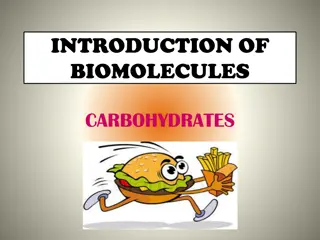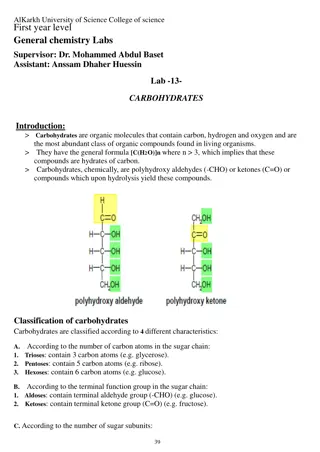Chemistry of Carbohydrates: Biochemical Classification & Importance
This chapter delves into the constituents of human food related to carbohydrates, discussing their biochemistry and nutritional significance. Explore the various classes of carbohydrates, from monosaccharides to polysaccharides, and their roles in plant structures and energy storage.
Download Presentation

Please find below an Image/Link to download the presentation.
The content on the website is provided AS IS for your information and personal use only. It may not be sold, licensed, or shared on other websites without obtaining consent from the author.If you encounter any issues during the download, it is possible that the publisher has removed the file from their server.
You are allowed to download the files provided on this website for personal or commercial use, subject to the condition that they are used lawfully. All files are the property of their respective owners.
The content on the website is provided AS IS for your information and personal use only. It may not be sold, licensed, or shared on other websites without obtaining consent from the author.
E N D
Presentation Transcript
Chemistry of Carbohydrates Objectives This chapter is aiming to discuss the carbohydrate constituents of human food. It is designed to familiarize the student with the biochemical classification of carbohydrates. The student will be informed with the nutritional availability and importance of various carbohydrate classes.
General characteristics They are polyhydroxyaldehydes or ketones Some time, they called (glycans) They have the following basic composition: (CH2O)n or H - C OH Compounds composed of C, H, and O (CH2O)n when n = 5 then C5H10O5
General characteristics Most abundant organic compounds in the plant world They are storehouses of energy They serve as components of supportive structures in plants (cellulose) They are essential components of nucleic acids (D-ribose (RNA) and 2-deoxy-Dribose (DNA))
Classification of Carbohydrates Monosacharides - simple sugars with multiple OH groups. Based on number of carbons (3, 4, 5, 6), a monosaccharide is a triose, tetrose, pentose or hexose. Disaccharides - 2 monosaccharides covalently linked. Oligosaccharides - a few monosaccharides covalently linked. Polysaccharides - polymers consisting of chains of monosaccharide or disaccharide units.
Classification of Carbohydrates Monosaccharides: Glucose, Fructose & Galactose Disaccharides: Maltose, Lactose & Sucrose Polysaccharides: Starch & Glycogen
Monosaccharides: CnH2nOn Also known as simple sugars Classified by 1. the number of carbons 2. whether aldoses (aldehyde) or ketoses (ketone) Most (99%) are straight chain compounds
Monosaccharides: All other sugars have the ending ose (glucose, galactose, ribose, lactose, etc ) The suffix -ose is added to a molecule that is a carbohydrate, and prefixes tri-, tet-, and pent- are used to indicate the number of carbons D-glyceraldehyde is the simplest of the aldoses (aldotriose) Pentosesand hexoses dominating
Monosaccharides: Sugar Nomenclature 3 carbon sugar triose 4 carbon sugar tetrose 5 carbon sugar pentose 6 carbon sugar hexose 7 carbon sugar heptose 8 carbon sugar octoses
Aldose sugars Where n is the number of asymmetric centers.
Ketose sugars Where n is the number of asymmetric centers.























